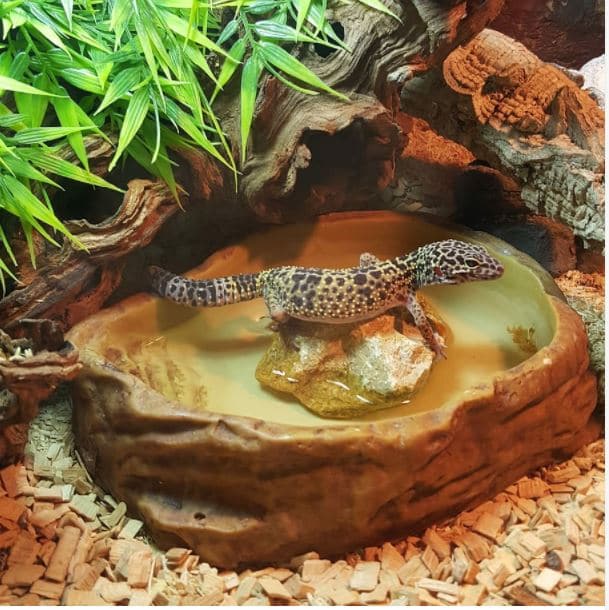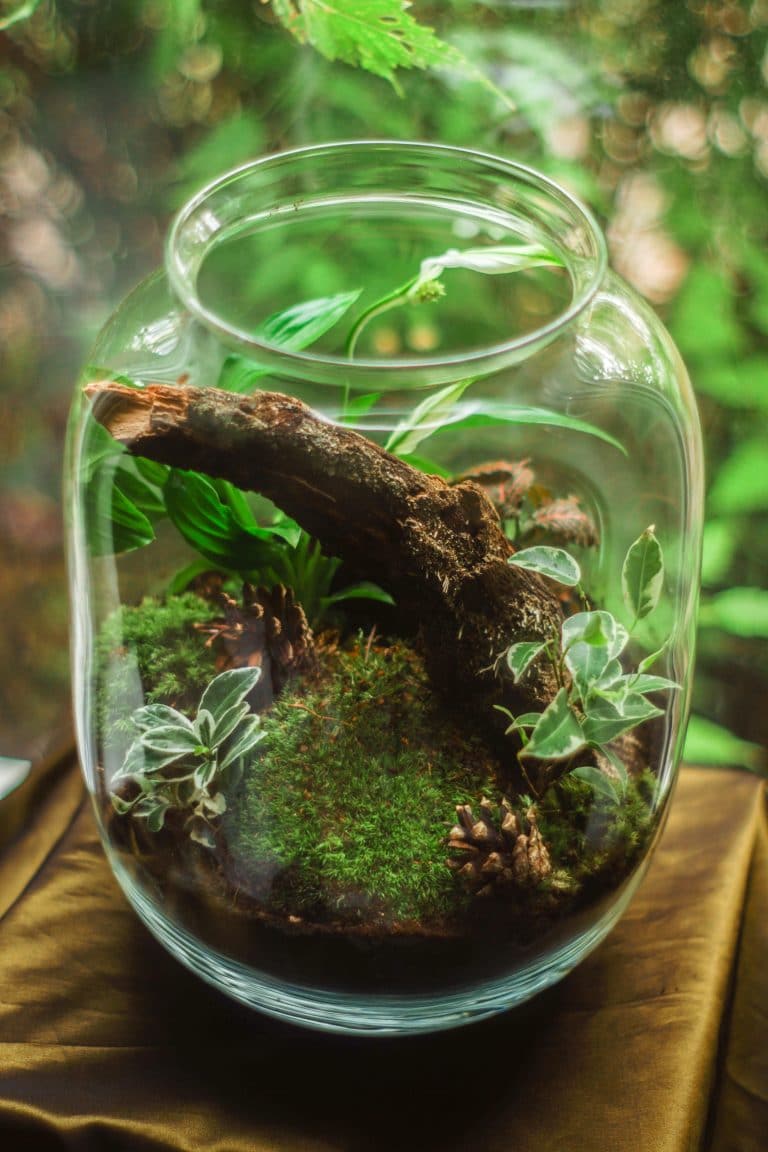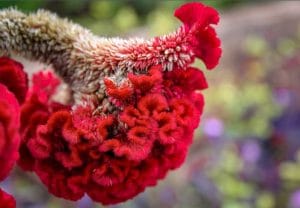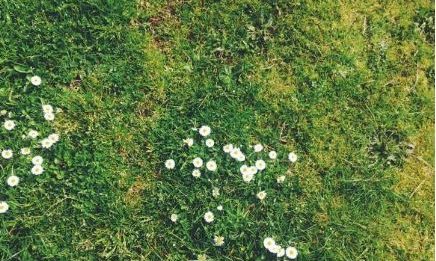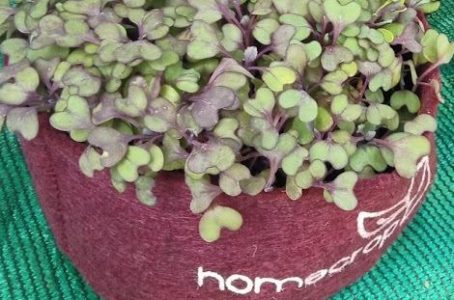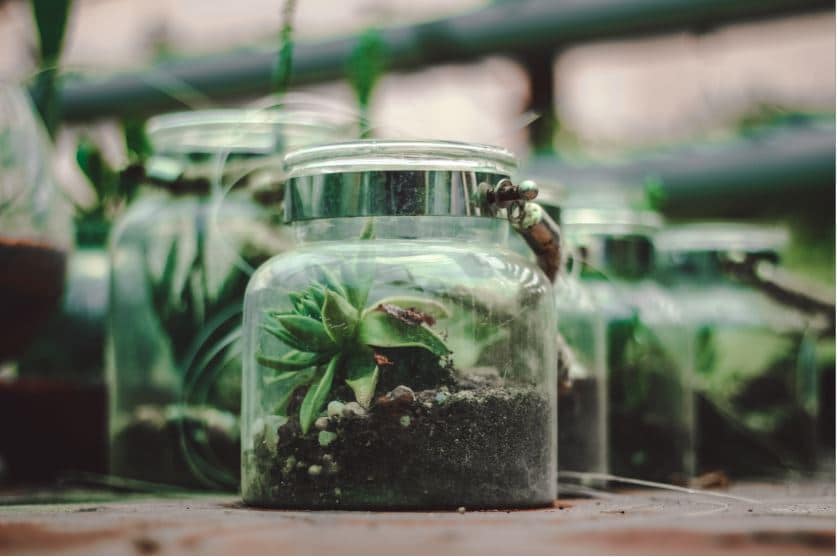
What is a closed terrarium?
A closed terrarium is a self-sufficient ecosystem inside a clear glass or plastic container that has a lid. It is basically, an indoor garden filled with small plants is built inside a sealed container. A miniature landscape is made inside the terrarium with its own rain cycle.
This site contains affiliate links to products. We may receive a commission for purchases made through these links. The price you pay is exactly the same if you do or do not use my links. There are no extras costs to you.
How does a closed terrarium work?
A complete small scale water cycle happens inside a terrarium.
Water is taken up by the roots, released into the air through transpiration, and then gets condensed.
Through the glass, the leaves absorb light and photosynthesize into energy that helps the plants to grow. The oxygen created during photosynthesis puts enough moisture in the air for it to rain back down on the plant.
As the leaves age, they drop to the bottom and rot helping to create carbon dioxide also needed for photosynthesis and nutrients that are absorbed by the roots. At night when there is no sunlight, the plants break down their nutrients and use cellular respiration to stay alive.
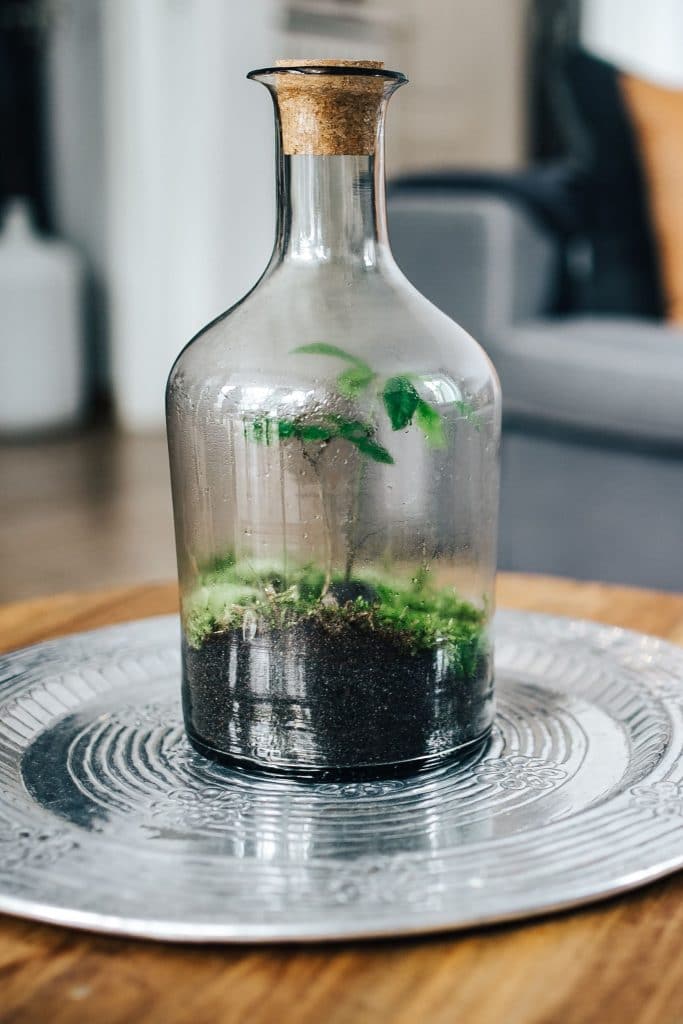
Is it easy to maintain a closed terrarium?
The closed terrarium needs attention till the rain cycle is established inside it. The condensation should look like a light fog (water droplets). If there is water or larger water drops on the foliage, we should remove the lid for excess water/moisture to evaporate. Once a perfect balance of light and humidity is established, the closed terrarium will become almost maintenance-free.
How much light does a closed terrarium need?
Closed terrarium must not be placed in direct sunlight, though it requires bright light. Direct sunlight will cook the plants. Also, terrarium glass can act as a magnifier and burn the plants.
So, light requirements depend on the type of plant we have in the terrarium. Some plants need very bright light and some need bit dimmer light.
Best soil for closed terrarium
Garden soil is heavy and will compact more easily. Soilless potting mix with some charcoal is a good choice. The low density of charcoal lightens heavy soils, which allows better root growth, increasing drainage and allowing air into the soil. Adding rock or pebbles at the bottom of the container does not help.
Do we need water closed terrarium?
Water only if condensation has stopped, the plants start to droop, or the soil feels dry.
What materials do I need to make a closed terrarium?
- A closed container – Plastic or a glass container with lid
- Pebbles/Gravel – Decorative layer
- Activated charcoal – keeps water fresh, removes toxins and odors, fight bacterial growth
- Mesh- prevents potting soil from sifting down into the pebbles
- Potting soil – Potting mix or Potting soil (not so good for a long run)
- Plants suitable for closed terrarium ( see the complete list here)
- Moss/chopped bark
- Small Isopods – It keeps the terrarium fresh and clean
- Finishing Tools – Scissors or snips

Closed terrarium layers
- Place pebbles or gravel in the base of the jar. Depending on the size of the terrarium, add one inch or half-inch pebble layer.
- Add a little bit of activated charcoal.
- Cut the mesh in the shape of the container and place it on the charcoal. Please note that this mesh will prevent soil from sifting down into the pebbles. So, see that you cut it a bit larger than the shape of the container.
- Add soil about 2 inches (again depending on the size of the jar) on top of the mesh.
- Consider your design before going to the next step. Plan your landscaping like where you want to place different plants, rocks, moss, ferns.
- Add plants ( see the complete list of plants suitable for Closed terrarium here). Place the larger plants in the background and the smaller plants in the foreground. See that you don’t overcrowd it with plants. Start with smaller plants first.
- Place moss around the plants.
- You can put rocks or wooden barks or wood for good landscaping to look more natural and realistic.
- You can add small Isopods too.
- The last step before closing the lid is to spray the mist over plants and moss.
Closed terrarium containers
Any lidded jar that has clear glass (even plastic container) is suitable for building a closed terrarium.
The idea is, the light should be able to pass through the container, and proper humidity and moisture are inside the jar.
Although any weirdly shaped jars work for a closed terrarium, the size, the shape, and the size of the opening of the containers make a difference.
For example, a narrow mouth jar may not be suitable for Succulents or cacti, but it works well for humidity-loving plants.
Some of the jars you can consider for a closed terrarium:
- Fishbowls
- Milk and wine bottles
- Light bulbs
- Glass domes
- Wardian cases
- Apothecary jars
What precautions we should take while creating a closed terrarium?
- We should be careful not to introduce pests and pathogens into our terrarium, as this humid enclosed environment is a perfect breeding ground.
- Wash hands or wear clean gloves.
- Wash the container with soap and hot water.
- Rinse well in cool water and air dry.
How can I get rid of mold in a closed terrarium?
Though molds are not harmful to plants, it indicates that some things are not fine inside the terrarium. There could be multiple factors for the appearance of mold.
- Poor drainage
- Soil is too wet
- Not enough airflow
- No proper/insufficient light
- Soil is contaminated
Mold growth can be stopped by:
- Controlling the moisture
- Sterile the terrarium
- Take the lid off for fresh air to get in
- Adding springtails – insects that eat molds, fungi, and decaying plant material
Are terrarium and vivarium both the same?
A vivarium is an area, usually enclosed, for keeping and raising animals or plants for observation or research.
A terrarium is a type of vivarium.
